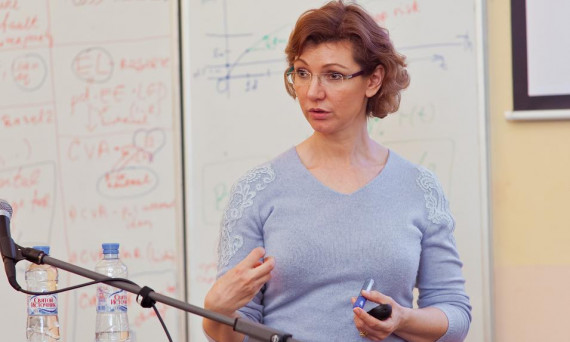The Third School held at the European University at St. Petersburg (EUSP) was organised with the generous support from Barclays Bank and JTI. The Third School in Risk Management, Insurance, and Finance took place on March 20–22, 2014. Karl-Theodor Eisele (University of Strasbourg, France), Olga Pavlova (Grizzly Bear Capital, London, UK), and Mario V. Wüthrich (ETH Zürich, Switzerland) covered such issues as «From Risk Measures to Solvency Accounting», «Analysis of the Monte Carlo CVA and Basel III CVA During and After the Financial Crisis of 2008–2009», and «Claims Reserving in Non-Life Insurance and its Prediction Uncertainty».
The Programme
 |
20 March, 2014: Risk Management day (6 hours)
From Risk Measures to Solvency Accounting by Professor Karl-Theodor Eisele, University of Strasbourg, France |
Summary of the Course
Our starting point are convex risk measures (or their negative values: concave risk assessments) and their robust representations in the one- and multi-period case. They may be regarded as possible answers to the problem of Knightian uncertainty or model risk. Several examples will be given; among them the representation of asymptotically stable assessments. Of particular interest are time-consistent risk assessments, the representations of which use in the coherent case m-stable sets of probabilities.
Our next step is to regard risk assessments of non-tradeable assets or liabilities in the presence of a financial market. Here, a central point to be discussed is the so-called supervisory arbitrage. If supervisory arbitrage is excluded, we are led to the problem of the existence of optimal replicating portfolios (ORP). Under ORPs, risk assessments are market-consistent and thus define their market-consistent envelope.
It turns out that this concept will become the essential tool of prudent supervision of banks and insurances. Based on a business plan e.g. of an insurance company, we introduce the concepts of supervisory provision and – margin. Next, we divide these items into their parts assigned to external capital and to own funds, respectively. This will lead us to the notions of risk margin and supervisory capital requirement. The relation between them is the cost-of-capital ratio. With the help of a bid-price operator, we give examples how the cost-of-capital ratio is calculated in the case of a finite risk horizon or in the stationary infinite case.
Finally we present the internal model of the European Solvency II project in its bottom-up version, and show how it coincides with the top-down version where the concepts worked-out so far will be used.
(Participants should have a good knowledge about measure and probability theory, including Lp spaces.)
 |
21 March, 2014: Finance day (6 hours)
Analysis of the Monte Carlo CVA and Basel III CVA During and After the Financial Crisis of 2008-2009 by Dr Olga Pavlova, Managing Partner at Grizzly Bear Capital, London, UK |
Summary of the Course
The course will focus on the main driving forces behind counterparty risk for a derivatives portfolio. First, we shall run through main simulation techniques for CVA. Then we shall compare the simulated CVA with Basel III CVA using historical data from 2008 to present. We shall comment on strengths and weaknesses of the Basel approximation in different market conditions using the simulated CVA as a benchmark.
About the lecturer:
Olga Pavlova holds a PhD in Mathematics and a Master in Finance degrees. Her work experience in the City started at Deutsche Bank (London) on the Market Risk Modelling team. She then joined the Quantitative Risk Analytics team at Barclays Capital (London). There, she was a Global Head of Credit Risk Analytics, covering risk modelling for all derivative classes. Among other projects, she represented the bank in regulatory approvals of Basel II and III capital requirements. She subsequently joined UBS (London) as a Head of Quantitative Business Analysis. In this most recent role, Olga looked at various capital optimisation techniques for portfolios of derivatives. She currently works as an independent consultant giving lectures on various topics in financial modelling with the main emphasis being on counterparty risk. She also supervises masters degree theses at the Department of Financial Engineering, Imperial College (London).
 |
22 March, 2014: Insurance day (6 hours)
Claims Reserving in Non-Life Insurance and its Prediction Uncertainty by Professor Mario V. Wüthrich, ETH Zurich, Switzerland |
Summary of the Course
Lecture 1: The claims reserving problem and the chain-ladder method. We introduce the claims reserving problem and the claims reserving terminology. Claims reserving is one of the most important tasks in a non-life insurance company. It aims at predicting cash flows of the outstanding loss liabilities. These predictions are needed for pricing of insurance products, for accouting of insurance business and for risk management purposes. We discuss these problems and we give first techniques that help to predict these cash flows.
Lecture 2: Stochastic chain-ladder model and prediction uncertainty. We present the stochastic chain-ladder model for claims reserving. The stochastic chain-ladder model is the most popular stochastic model that is used for claims reserving. On the one hand it is simple and on the other hand it provides quite reasonable predictions. We discuss this model and analyze the quantification of prediction uncertainty.
Lecture 3: The claims development result for solvency considerations. The quantification of prediction uncertainty is usually done over the entire run-off of the outstanding loss liabilities (long-term behavior). For modern solvency considerations we should also investigate the short-term behavior, i.e. by which amount the claims reserves may change over the next accounting year. This leads to the consideration of the claims development result. We discuss this claims development result and analyze the quantification of prediction uncertainty in this short-term view.
Lecture 4: Dependence modeling on claims reserving triangles. All the previous considerations are done under rather restrictive model assumptions about dependence, namely one makes strong assumptions about independence. In this lecture we relax these independence assumptions and we analyze the sensitivities of the results by allowing for dependence. We will observe that this increases the confidence bounds substantially.
The Organising Committee
- Jan Dhaene (KULeuven)
- Andrey Kudryavtsev (EUSP)
- Maxim Bouev (EUSP)
- Marina Kondrashova (EUSP)
Partners and Supporters
The School greatly benefited from generous donations from
 |
Information about the School was circulated via
 |
Photo Report of the School 2014
{gallery}news/2014/20-22_03{/gallery}
